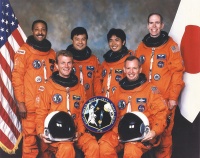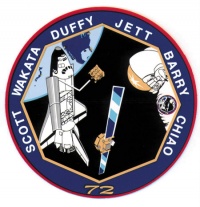STS-72
From The Space Library
 | |
| Organization | NASA-Office of Space Flight (United States) |
|---|---|
| Mission type | Human Crew |
| Launch date | January 11, 1996 |
| Launch vehicle | Space Shuttle |
| Launch site | Cape Canaveral, United States |
| COSPAR ID | 1996-001A |
| Inclination | 28.45 degrees |
| Experiments | Here |
| Alternate Names | 23762 |
| Additional Information | Here |
| Data Collection | Here |
| Payload Mass Up | 6510 kg |
| Payload Mass Down | 10105.91 kg |
| Orbiter | Endeavour |
| Lift Off Mass | 2,052,252.27 kg |
| Orbiter Weight at Liftoff | 112,417.73 kg |
| Orbiter Weight at Landing | 98,758.64 kg |
| Landed | Concrete runway 15 at Kennedy Space Center, Fla. |
| Orbits of Earth | 142 |
| Orbital Altitude | 250 nautical miles (288 statute miles) |
Contents |
Crew
- Commander: Brian K. Duffy
- Pilot: Brent W. Jett Jr.
- Mission Specialist 1: Leroy Chiao
- Mission Specialist 2: Winston E. Scott
- Mission Specialist 3: Koichi Wakata, National Space Development Agency of Japan
- Mission Specialist 4: Daniel T. Barry
Mission
STS 72 was a US shuttle spacecraft launched from Cape Canaveral. It carried, released, and retrieved the OAST Flyer. It also retrieved a long orbiting Japanese reusable spacecraft, SFU, that had amassed astronomical data and material science products since March 1995. The primary objective of the STS-72 mission was to capture and return to Earth a Japanese microgravity research spacecraft known as Space Flyer Unit (SFU). The 7,885lbs SFU spacecraft was launched by Japan's National Space Development Agency (NASDA) from Tanegashima Space Center in Japan at 8:01 UT on March 18, 1995 aboard a Japanese H-II rocket (HII-3). The STS-72 mission also deployed (for about 50 hours) and then retrieved the Office of Aeronautics and Space Technology Flyer (OAST-Flyer) spacecraft. OAST-Flyer was the seventh in a series of missions aboard reuseable free-flying Spartan carriers. It consisted of four experiments: Return Flux Experiment (REFLEX), Global Positioning System Attitude Determination and Control Experiment (GADACS), Solar Exposure to Laser Ordnance Device (SELODE) and the University of Maryland Spartan Packet Radio Experiment (SPRE). Other experiments onboard STS-72 included the Shuttle Solar Backscatter Ultraviolet Experiment (SSBUV-8) (previously flown on STS-34, STS-41, STS-43, STS-45, STS-56, STS-62 and STS-66), EDFT-03, Shuttle Laser Altimeter Payload (SLA-01/GAS(5)), VDA-2, National Institutes of Health NIH-R3 Experiment, Space Tissue Loss Experiment (STL/NIH-C), Pool Boiling Experiment (PBE) (hardware previously flown on STS-47, STS-57 and STS-60) and the Thermal Energy Storage (TES-2) experiment (previously flown on STS-69). Get Away Special payloads included the United States Air Force Academy G-342 Flexible Beam Experiment (FLEXBEAM-2), Society of Japanese Aerospace Companies' G-459 - Protein Crystal Growth Experiment and the Jet Propulsion Laboratory GAS Ballast Can with Sample Return Experiment. Endeavour's 10th flight also included two 6.5 hour spacewalks by three astronauts to test hardware and tools that will be used in the assembly of the International Space Station starting in late 1997. EVA-1 on flight day five consists of Crewmembers Leroy Chiao (EV1) and Dan Barry (EV2) while EVA-2 on Flight Day 7 consists of Leroy Chiao (EV1) and Winston Scott (EV2).
EVA
Extravehicular Activity (EVA) conducted by Leroy Chiao, Daniel Barry, and Winston Scott during two spacewalks for a total of 13 hours, 2 minutes. EVA 1, Chiao and Barry, 6 hours, 9 minutes; Chiao and Barry evaluated a new EVA workstation, a movable stanchion that provides stability for astronauts and holders for tools, a flexible foot restraint, and a rigid umbilical that may be used on the International Space Station to hold fluid and electrical umbilicals in place. EVA 2, Chiao and Scott, 6 hours, 53 minutes; Chiao and Scott evaluated a utility box designed to hold avionics and fluid line connections on the space station, an on-orbitinstalled slidewire to which tethers can be connected, thermal improvements of space suits, and a wrist-mounted computer called the electronic cuff checklist. They also took measurements of the forces induced by work.
Payload
Space Flyer Unit (SFU) retrieval; Office of Aeronautics and Space Technology (OAST) Flyer; Shuttle Solar Backscatter Ultraviolet (SSBUV/A; Shuttle Laser Altimeter (SLA) 01/Getaway Special (GAS)(5); Extravehicular Activity Development Flight Test (EDFT) 03; Physiological and Anatomical Rodent Experiment (PARE)/National Institutes of Health (NIH) Rodents (R) 03; Protein Crystal Growth (PCG) Single-Locker Thermal Enclosure System (STES) 04; Commercial Protein Crystal Growth (CPCG) 08; Space Tissue Loss (STL)/ National Institutes of Health (NIH) Cells (C) 05
Books about the Space Shuttle Program
Buy This Book Click here |
Buy This Book here |
Buy This Book Click here |
Buy This Book Click here |





